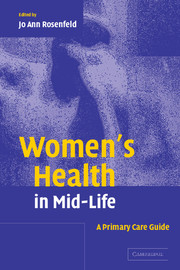Book contents
- Frontmatter
- Contents
- List of contributors
- 1 Introduction
- Part I Health promotion
- Part II Hormonal changes
- Part III Disease prevention
- 12 Prevention of coronary heart disease in women
- 13 Hypertension and stroke
- 14 Diagnosis and treatment of osteoporosis
- 15 Diabetes in mid-life women
- Part IV Cancer prevention
- Index
- References
15 - Diabetes in mid-life women
from Part III - Disease prevention
Published online by Cambridge University Press: 21 August 2009
- Frontmatter
- Contents
- List of contributors
- 1 Introduction
- Part I Health promotion
- Part II Hormonal changes
- Part III Disease prevention
- 12 Prevention of coronary heart disease in women
- 13 Hypertension and stroke
- 14 Diagnosis and treatment of osteoporosis
- 15 Diabetes in mid-life women
- Part IV Cancer prevention
- Index
- References
Summary
Case: a 51-year-old woman who has had type 2 diabetes for five years is managed with metformin, diet, and exercise. She notes worsening hyperglycemia, but attention to diet and exercise does not seem to improve glycemic control as it has in the past. She mentions to her physician that she has missed her last two menstrual periods and that she seems to be a “bit more edgy.” She wonders whether there is a correlation between her worsening diabetes control and her menstrual changes.
Definitions
Diabetes mellitus refers to a group of common metabolic disorders characterized by hyperglycemia. Diabetes may be type 1 (juvenile-onset or insulin-dependent diabetes mellitus – IDDM), type 2 (adult-onset or non-insulin-dependent diabetes mellitus – NIDDM), or gestational (during pregnancy). In type 1 diabetes, hyperglycemia is caused by an absolute deficiency of insulin secretion. In type 2 diabetes, hyperglycemia is caused by a combination of insulin resistance and inadequate compensatory insulin secretory response, with a relative, not absolute, insulin deficiency.
The most common type of diabetes in mid life is type 2 diabetes, often caused by a combination of inherited and environmental factors and lifestyle choices. Type 2 diabetes is associated with numerous metabolic abnormalities, including reduced insulin secretion, increased hepatic glucose production, decreased glucose uptake by muscle and adipose tissue, and dyslipidemia. These metabolic abnormalities underlie the complications of diabetes, including heart attack, stroke, blindness, end-stage renal disease, and lower-extremity amputation.
Keywords
- Type
- Chapter
- Information
- Women's Health in Mid-LifeA Primary Care Guide, pp. 253 - 272Publisher: Cambridge University PressPrint publication year: 2004



